| Rusty tussock moth | |
|---|---|

| |

| |
| male imago and caterpillar | |
| Scientific classification | |
| Domain: | Eukaryota |
| Kingdom: | Animalia |
| Phylum: | Arthropoda |
| Class: | Insecta |
| Order: | Lepidoptera |
| Superfamily: | Noctuoidea |
| Family: | Erebidae |
| Genus: | Orgyia |
| Species: | O. antiqua |
| Binomial name | |
| Orgyia antiqua (Linnaeus, 1758) | |
| Synonyms | |
| |
Orgyia antiqua, the rusty tussock moth or vapourer, is a moth in the family Erebidae.
Distribution and status
O. antiqua is native to Europe, but now has a transcontinental distribution in the Palaearctic and the Nearctic regions. The species is not on the IUCN (2007) Red List; and in the UK is considered a common resident.
Habitat
In the UK, O. antiqua may be encountered in a variety of shrub-based habitats, including gardens, parks, open woodland, fens, hedgerows, heaths. and moors.
Description
For a key to the terms used, see Glossary of entomology terms.A striking dimorphism exists between the male and the female moths of this species. The male moth typically has orange- to red-brown (ochreous red and dark brown) wings; each fore wing has a white comma-shaped (tornal) spot. It has marked plumose (short, bipectinate) antennae. The wingspan measures between 35 and 38 mm. The female moth has vestigial wings and is flightless; it is light grey-brown (ochreous grey), has "shortly bipectinate" antennae, and a swollen abdomen. The compound eyes of the two sexes differ not only with regard to their size, number of facets and internal organization and ultrastructure, but also with regard to their sensitivity to ultraviolet radiation The hairy caterpillar is spectacular, with "humps", "horns", and a "tail" in a combination of dark grey, red, and yellow.
Lifecycle
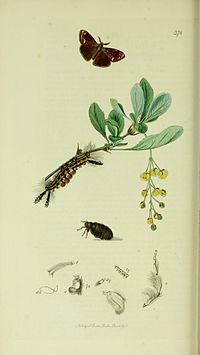
 Late instar caterpillar showing the four clumps of dorsal tussock hairs
Late instar caterpillar showing the four clumps of dorsal tussock hairs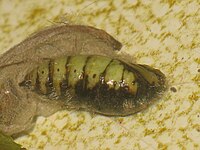 The pupa
The pupa The flightless female clings to her cocoon during her brief adult life
The flightless female clings to her cocoon during her brief adult life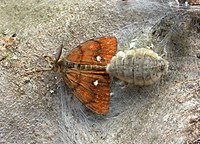 Mating pair (male at left), illustrating their stark sexual dimorphism
Mating pair (male at left), illustrating their stark sexual dimorphism
Egg
Several hundred eggs are laid on the outside of the female's empty cocoon, usually attached to a host plant or something close by (e.g. fence, wall). The species overwinters in the egg stage. Each brownish egg is rounded, somewhat flattened top and bottom. A small darker depression is seen in the upperside.
Caterpillar
The larvae hatch early in the spring, as soon as foliage starts to appear. They are easily recognized by their horn-like tufts of hair-like setae. Four toothbrush-like tufts occur along the back, and hair pencils project from the sides at the front and at the back. The body is dark grey to black, and red tubercules are along the sides and back.
They have defensive glands at the back, and wipe their setae against them to charge them with toxins. They grow to about 30–40 mm, females being considerably larger than males. In the UK, caterpillars can be found between May and early September.
The caterpillar is a minor forest pest in North America, and may become a pest in cities in the UK.
Pupa
The pupa forms in a crevice (e.g. in tree bark or fence) inside a silk cocoon. It is glossy black and hairy.
Imago
The male flies in a zigzag pattern—often high up in search of females—and is active during the day or at night. Males occasionally come to light. In New Brunswick, adult males are attracted to pheromone traps set in commercial forests for white-marked tussock moth (O. leucostigma).
The female is flightless, spending her brief life attached to her cocoon. The female attracts other males via release of a pheromone, the males find the female via the concentration gradient of the released pheromone. The female mates and lays her grey-yellow eggs in large numbers on her fine-meshed cocoon.
The adult moths do not feed, so they only live for a short time. The two (sometimes three) generations fly from May till October; in North America, only one generation occurs in a year. In the UK, one protracted generation, from July to October in the south, and from September to October in the north, is believed to happen.
The males are diurnal, flying during the day, but are occasionally attracted to light.
Host plants
Caterpillars are polyphagous and feed on a wide range of deciduous trees and shrubs, such as birch (Betula), Crataegus, lime (Tilia), Prunus, Quercus, Rubus, Salix, Tamarix, Vaccinium, Aeonium haworthii or Delonix regia.
In Scotland, the species is almost always found on birch, but has also been recorded damaging Sitka spruce.
Gallery
-
 rear view of "calling" female
rear view of "calling" female
-
 mating
mating
-
 female laying her eggs on the remains of her own cocoon
female laying her eggs on the remains of her own cocoon
-
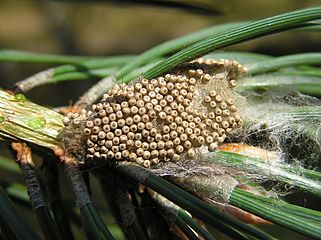 egg-mass on an empty cocoon amongst conifer needles
egg-mass on an empty cocoon amongst conifer needles
-
 eggs (close up)
eggs (close up)
-
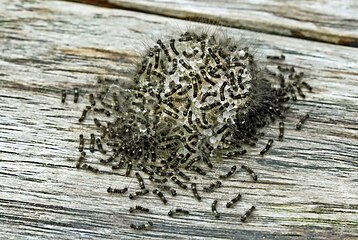 young larvae
young larvae
-
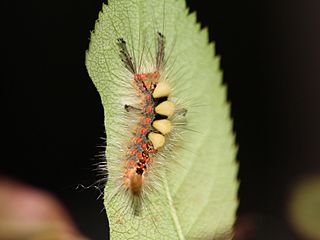 late instar larva on rose leaf
late instar larva on rose leaf
-
 volant male imago
volant male imago
Illustrations
References
- Arnaud Jr., Paul Henri (1978). "A Host-parasite Catalog of North American Tachinidae (Diptera)". Miscellaneous Publication (United States. Dept. Of Agriculture) (1319). Retrieved 8 March 2018.
- Explanation of name "vapourer"
- ^ Carter, Nelson E. (2004). Status of forest pests in New Brunswick in 2003. Department of Natural Resources, Fredericton, New Brunswick. pp. 7–8.
- IUCN (2007), 2007 IUCN Red List of Threatened Species
- ^ Waring, Paul; Townsend, Martin; Lewington, Richard (2003). Field Guide to the Moths of Great Britain and Ireland. British Wildlife Publishing, Hook, UK, p. 208.
- ^ de Worms, C. G. M. (1979). "Lymantriidae". In Heath, J.; Emmet, A. M.; et al. (eds.). The Moths and Butterflies of Great Britain and Ireland. Vol. 9 Sphingidae–Noctuidae Noctuinae and Hadeninae. London: Curwen Books. p. 70.
- Lau, Stanley TF; Meyer-Rochow, Victor Benno (2007). "The compound eye of Orgyia antiqua(Lepidoptera; Lymantriidae): sexual dimorphism and light/dark adaptational changes". European Journal of Entomology. 104 (2): 247–258. doi:10.14411/eje.2007.039.
- Mishra, Monalisa; Meyer-Rochow, Victor Benno (2008). "Eyes of male and female Orgyia antiqua (Lepidoptera; Lymantriidae) react differently to an exposure with UV-A". Micron. 39 (4): 471–480. doi:10.1016/j.micron.2007.02.006. PMID 17419066.
- ^ Wagner, D.M. (2005). Caterpillars of eastern North America. Princeton University Press.
- ^ Porter, Jim (1997). The Colour Identification Guide to Caterpillars of the British Isles. Viking, London, p. 80.
- Pinder, P. S.; Hayes, A. J. (1986). "An outbreak of Vapourer Moth (Orgyiaantiqua L.: Lepidoptera Lymantridae) on Sitka spruce (Picea sitchensis (Bong.) Carr.) in Central Scotland". Forestry. 59 (1): 97–106. doi:10.1093/forestry/59.1.97. ISSN 0015-752X.
External links
- The Vapourer on UKMoths
- Fauna Europaea
- Lepiforum.de
- JustGreen Bug of the Month (PDF) Archived 15 January 2006 at the Wayback Machine
- Good plant protection practice (PDF)
| Taxon identifiers | |
|---|---|
| Orgyia antiqua |
|


